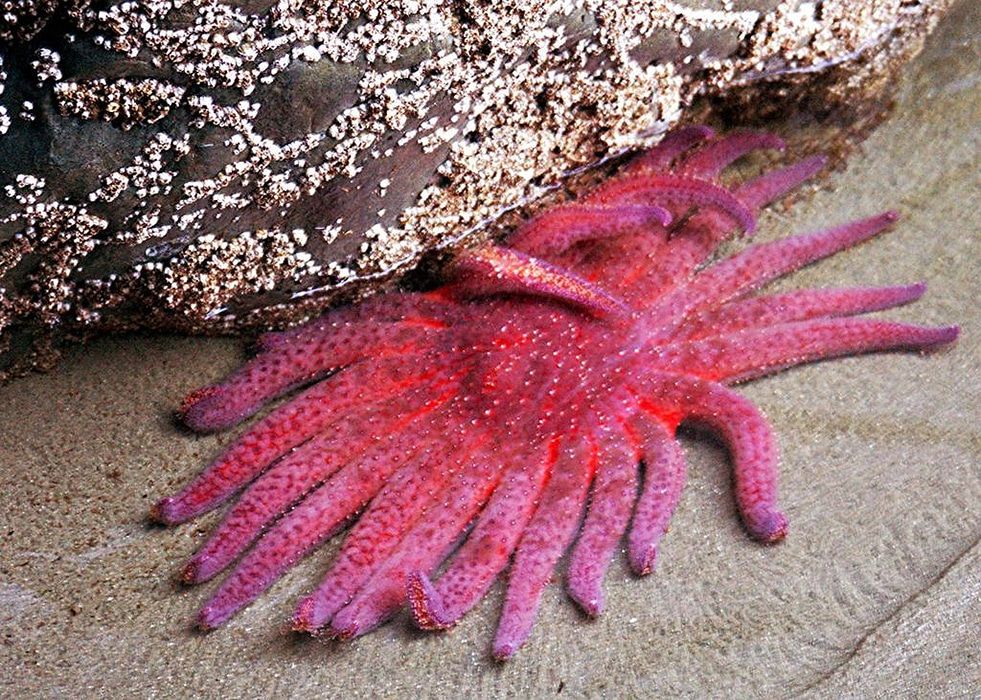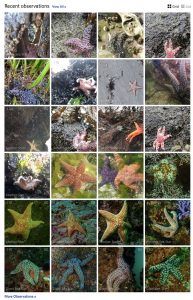Sea stars pushed to edge of extinction by warming oceans
By Rochelle Baker | August 20, 2020
 Sunflower sea star (Pycnopodia helianthoides), one of the species most severely hit. Image courtesy of Wikimedia Commons.
Sunflower sea star (Pycnopodia helianthoides), one of the species most severely hit. Image courtesy of Wikimedia Commons.
Editor’s note: This story was originally published by Canada’s National Observer. It appears here as part of the Climate Desk collaboration.
Every child who has ever explored a West Coast shore relishes the discovery of a sea star (formerly known, confusingly, as a starfish), with its bumpy skin, jumble of arms, and striking colors. But this once-common treasure of the tidal pool is at risk of being eradicated along the Pacific coastline from a deadly combination of disease and warming oceans caused by climate change, said biologist Alyssa Gehman of the University of British Columbia and the Hakai Institute. “It’s hard when you’re thinking about conservation of a species,” said Gehman. “Because climate change, well, that’s a very big problem to address.”
The problem surfaced in 2013, when sea star wasting disease sea was spotted along the British Columbia and Washington coasts.
It then rapidly began to lay waste to many as 20 different sea star species from Mexico to Alaska, said Gehman, a researcher with the University of British Columbia and the Hakai Institute. The syndrome, linked to a virus, starts as white lesions on the sea stars, but quickly causes their arms to fall off and reduces the creatures to white piles of mush.
“It looks like they are melting away,” Gehman said. “It’s really sad.”
Two of the most affected sea stars, the ochre and the sunflower stars, were once abundant on the British Columbia coast, but both were ravaged by sea star wasting disease, she said.
The sunflower sea star has been hit especially hard. Large, fast, and in a range of colors, the sunflower star can boast 15-to-24 arms that might span up to a meter across. But the species has suffered a massive die-off. There’s been up to a 90-percent decline in overall population, with the complete disappearance of sunflower stars in some southern areas of the US coast, Gehman said. “You used to be able to go out during a low tide and turn over some rocks, or look around, and you would find these big, beautiful stars,” she said. “I personally really loved that star. And so seeing that level of die-off is devastating.”
The loss is so widespread, persistent, and alarming that Gehman and a group of her peers are trying to get the sunflower sea star registered as a threatened species. Research indicates rising sea temperatures linked to climate change makes the sea stars more vulnerable to a virus that previously had isolated effects on sea star populations—but is now pushing some to the edge of extinction, said Gehman.
Lab experiments also show infected stars die faster and suffer a higher mortality rate in warmer water, she said. But it’s still not entirely clear what higher temperatures do to the virus in the water, she added.
Video courtesy of Grant Callegari and Josh Silberg/Hakai Institute
Ripple effect on marine ecosystems. Aside from the alarming loss of sea stars, their disappearance has larger, ongoing implications for the marine ecosystem, Gehman said. Both sunflower and ochre stars—the purple-and-orange starfish found clinging to rocky beaches and piers that people along the British Columbia coast are most likely to recognize—are keystone species. Both have a disproportionately large influence in their ecosystem, Gehman said. Ochre stars keep mussel colonies along rocky shorelines at bay, allowing other plants and animals to thrive. Sunflower stars, in particular, are voracious eaters that can swallow sea urchins whole, keeping their populations in check.
But now without this primary predator, sea urchins are mowing down kelp forests.
In British Columbia, the decline in the sunflower star is linked to rising urchin numbers and a 30-percent decline in kelp forests, a fundamental source of food and habitat for a range of marine animals, including otters, seals, and fish.
However, there does seem to be pockets of recovery of the ochre star along the British Columbia coast, said Gehman.
But what’s unclear is how extensive those populations are, and if they will last.
“On the central coast, we’ve definitely seen some recovery, but we also appear to be seeing what look like seasonal outbreaks in the late summer,” said Gehman, adding, again, that warmer water appears to be an aggravating factor. “So while we’re seeing more ochre stars, the disease is not gone.”
Researchers in Oregon also noted an unusual and dramatic jump in baby ochre star populations, but it’s not clear if it’s a response linked to sea star wasting disease or whether the populations can avoid contracting the virus, Gehman said.
Gehman’s own research looks at whether different sea star species, such as the leather star, are more resistant to the disease. However, the sunflower star is still in peril and has only been detected in isolated areas along the British Columbia, Washington, and Alaska coasts. Divers in the Discovery Islands off the east coast of Vancouver Island recently reported seeing sunflower stars, Gehman said.
“We’re still seeing some, but they are variable, small populations—and generally small individuals.”

Citizen scientists can monitor sea stars. It’s difficult for researchers and scientists to monitor the entire Pacific coastline for sea stars, Gehman noted. So, there’s a push to educate the public about sea stars and to encourage them to become citizen scientists and help researchers monitor populations in their areas, she said.
An especially useful tool is the iNaturalist app that can be downloaded to cellphones, Gehman said. If people see sea stars, they can take photos and record data on the app about their sightings and provide valuable information to researchers. “Then we can start to track where we’re seeing growth and potential evidence of the recovery of sea stars,” Gehman said. “And also, anywhere we’re seeing pockets of disease.”
Scientists are scrambling to determine how exactly the virus, warm water, and other factors might be causing the massive impacts of sea star wasting disease.
“That way, we can identify mitigating factors, so that we can try to lessen the negative effects of climate change on this species,” Gehman said.
But addressing climate change is the most obvious step to try to ensure sea stars’ survival. “We should care because it could be a bellwether of things to come,” Gehman said. “We should know why and how that happened so that we can get an idea of whether that’s going to happen again in other systems.”
But it’s also important just to ensure the magic and beauty of sea stars continue to exist along our coastlines, Gehman said.
“At a personal level, sea stars are beautiful and interesting and many people love them.”
—Rochelle Baker/Local Journalism Initiative/Canada’s National Observer
![]()
Together, we make the world safer.
The Bulletin elevates expert voices above the noise. But as an independent nonprofit organization, our operations depend on the support of readers like you. Help us continue to deliver quality journalism that holds leaders accountable. Your support of our work at any level is important. In return, we promise our coverage will be understandable, influential, vigilant, solution-oriented, and fair-minded. Together we can make a difference.
Keywords: animals, climate change, climate crisis, global warming, sea stars, warming oceans
Topics: Climate Change















you want to blame someone go blame big oil and big gas.